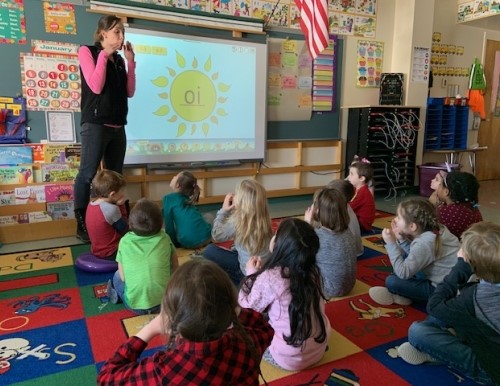
Reading and writing are two of the most fundamental elements of learning, and a child’s ability to grasp these elemental concepts is important to their academic and personal confidence as they make their way through school. Windham Primary School (WPS) has implemented a new way to teach reading and writing and the effect on student learning is astounding.
Alumna Jennie Smith-Brock, who received her M.S. in Special Education in 2016, and Kiely Treschitta, a candidate for her Certificate of Advanced Study in Literacy Education, both from the University, are making a difference for students at WPS. Smith-Brock trains teachers in a new method for teaching reading and writing called Jolly Phonics.
Not just another phonics program, Jolly Phonics has had students and teachers alike enjoying lessons that have garnered previously unimaginable results. “Teachers look forward to teaching these lessons at our school because students are engaged and our data shows growth,” Says Treschitta.
Smith-Brock has taught this method at Russell School in Gray, Calais Elementary and Wayflete in Portland and the data speaks for itself. “Schools in Maine that have implemented Jolly Phonics have typically seen a reduction by 1/3 to 1/2 in the percentage of kindergarteners performing below grade level on district reading and writing assessments and a doubling of the percentage of kindergarteners performing above grade-level,” says Smith-Brock.
Often times children who have trouble grasping foundational lessons in reading and writing would continue to have difficulty as they progress in school. “Those who did not learn to read easily, continued to struggle throughout primary school,” notes Julie Young, an Instructional Leader at WPS. But implementing Jolly Phonics in the classroom has changed that pattern for the better. “Our end-of-year Kindergarten DRA2 benchmark is a level 4,” says Young. “In previous years only a handful of students read beyond a DRA level 4. Last year most students reached the DRA4 and continued to much higher levels with many students reading a year or more above grade level.” And as the students’ reading improved, so did their writing.
Proven to go hand-in-hand, those who read well and often, will improve their writing skills as a result. “Jolly Phonics has helped children become braver writers; persevering to write unknown words,” observed Laura Record, a kindergarten teacher at WPS. She remarked on a fundamental change in the attitudes of her students when it comes to reading and writing. “It is rare to hear children say “I can’t.” Instead, they are helping each other find letters to match sounds in words. With students not struggling as much to write words in their stories, they focus more on their actual story and the story-telling process.”
Parents have also taken notice of the astounding progress of their children. “It impressed me how one program could benefit two types of learners,” Notes Jenny Hopkins, a parent of twins at WPS. “I am happy to report that at the end of kindergarten, my struggling reader was reading at grade level and my average reader ended the year reading above grade level. They are now entering first grade feeling successful and confident in their ability to read and write!”
Dr. Kyle Rhoads, WPS’s Principal, adds, “I was also the parent of a kindergartener. I was shocked by her reading development because of the skills she learned from Jolly Phonics and the instructional practices of her teacher. At home she would mimic the sound movements, sound out difficult words and say the sounds as she wrote words. Her motivation, enthusiasm and confidence from Jolly Phonics truly impressed me as an educator and as a parent!”
The data behind Jolly Phonics in the schools in which it has been implemented is encouraging for all those who take part in the education of young minds. “Jolly Phonics provided a skill that my students in the past were lacking, or under using,” comments Lindsey Pettus, a kindergarten teacher at WPS. “[Jolly Phonics] unlocked the door for reading and writing at a new pace and level than I had seen in 12 previous years of teaching kindergarteners, and above all it was enjoyable for the students and teachers alike.”

